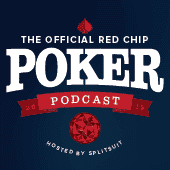Doug Hull joins Zac Shaw for an episode focused on Live $1/$2 NL and announces our newest product: the Crash Course. Hull shares specific strategies he teaches his $1/$2 students.
As Hull explains, Crash Courses are collections of Red Chip Poker videos, podcasts and articles, all themed on a specific topic. The first two Crash Courses (Live $1/$2 NLHE and MTT) will launch for PRO members this first week of November, and to the general public shortly thereafter.
Our existing PRO members will be able to access these Crash Courses as a regular part of their membership. For those who want to see what we’re all about, this is a golden opportunity to develop the skills you need to be a big, consistent winner… all for a fraction of a buy-in at $1/$2.

Mission: Possible
Hull begins by talking about the utility of doing “missions”, or specific strategic exercises, to develop the intuition and pattern recognition skills neaded to get great results at $1/$2. He discusses the missions in the back of his book Poker Plays You Can Use as a great way to train yourself to apply what you’ve learned while studying poker.
Doug has been teaching all his life… math, engineering and now poker. He noticed that students thrive when they have missions requiring execution of the strategies he teaches.
Never Limp
Hull’s boilerplate advice to the average $1/$2 NL player is to stop limping. Much as Ed Miller would recommend, Hull’s encouragement to students who struggle with limping too much is to quit cold turkey. This develops a positive stimuli reaction to saving money on flops not hit, instead of that “Grrr” reaction to being fleeced out of a pre-flop wager.
While limping certainly gets worked back into your game, never limping is a classic exercise to teach pre-flop discipline and a generally aggressive style of poker that builds advantages beyond your strict two-card holding.
Shaw confirms this totally worked for his game, as documented in his Strategy in Action series.
Unstudied Players
Hull discusses the pair of videos he made on the thought process of unstudied players (which appear in the Live $1/$2 NLHE Crash Course). He says $1/$2 NL players that haven’t had an opportunity to study the game often approaching this with a “I’m gonna win this pot” mentality vs. a “I’m gonna profit over the long-term” mentality. This leads to some pretty strange decisions, but if you’re able to get into the mind of the unstudied player, you can make some very exploitative plays.
One such example Hull points out is the exploitative river fold vs. an unstudied nit player. If you try to double-barrel an unstudied nit opponent and they fire a bet on the river, they have the nuts. This allows you to make some very exploitative folds, even when pot odds may be in your favor.

Exploiting Nits
Hull expands on the exploitative folds idea, and talks about an infamous hand on Live at the Bike where he raised on the button with AK and was 3-bet by a nit. He folded, even though technically he should never fold in that spot. With the knowledge that his opponent was only 3-betting QQ+, he says it was an easy laydown.
Another one of Hull’s “Exploit the Nit” routines involves a nit who calls a pre-flop raise out of the blinds, the flop comes A 7 2 rainbow, he checks, normally this would be a standard c-bet. However, nits will give you perfect information if you check. If the turn comes out and he checks, he never has an ace. Should he bet, it’s guaranteed. So you can delay your c-bet for perfect information in this situation.
Pattern Recognition
“Poker is like chess in that it is a pattern recognition game,” Hull says.
The key here is that by experiencing the same thing over and over, and being able to recognize those patterns, we offload our cognitive process, because we’ve already worked through that spot and see when it pops up in the game. We don’t have to reinvent the wheel during every hand and try to figure out how things work from scratch.
Finding these ways of simplifying the game — like Ed Miller’s simplification of board textures in his book The Course.
Bread and Butter
“If you are the last aggressor pre-flop, and after the flop you are in position, and you have exactly one or two opponents who are, of course, out of position, then you are in a bread-and-butter situation,” he says. “This is a great situation and it should be very profitable.”
The “Bread and Butter” spot was a term coined by venerable poker author Tommy Angelo. The idea is that these spots will generate auto-profit for you, so by default you should play them aggressively.
Hull encourages players to observe when these bread-and-butter situations come up, and the positive results that come from exploiting this spot.
The Jedi Moment
Hull will still do this sometimes: When a table presents nitty, tight action and he’s up against a wall, he’ll start playing the hijack and button aggressively with any two cards until someone plays back at him. The results have been surprisingly good. These types of players usually take many, many orbits before they catch on to how they are being exploited by players in position.
Online Poker Training
Something that host Zac Shaw touched on in a previous episode of Strategy in Action is the idea of using online poker as a way to study aggression for live cash games. Hull concurs. Online poker is a great tool to try out new moves and techniques without risking substantial sums of money.
“I personally use online cash more as a laboratory than anything else,” he says.
Working Aggression in Your Game
“A lot of people that are getting good at poker, they’ve correctly figured out they have to play tighter,” Hull says. Where the aggression comes in, is adding more hands on the hijack and the button. This is a perfect way to inject more aggression.
“You should be raising the button something like 50% of the time if it’s folded to you,” he says. Eight-six suited can be a raising hand on the button in this scenario.
Hull references his Pre-Flop Open Raise Range infographic in discussing how pre-determined ranges factor in to playing pre-flop.
He cautions against taking the more marginal spots when you’re first starting out, because they require significant post-flop skills. Particularly when you’re out of position, you need to be careful about expanding your range versus players that are capable of fighting back.
Get the Crash Course
Like what you heard about beating $1/$2 NL hold ’em? You’re going to want to check out our Live $1/$2 Crash Course. Questions or comments? Discuss this podcast in our forums.

You hit the nail on the head when you talked about having an opening range but not knowing what to do with some semi-bluffs (i.e. Miller A5s-A5s bluff ranges). I have them memorized but get stranded once we open with suggested semi-bluffs and get called.
is there anywhere here that you expand on the jedi moment?
While we didn’t expand on it here, our Playing More Aggressive podcast is a great place to pick up some of those aggressive Jedi moves.